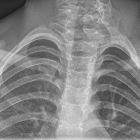Sprengel deformity





















Sprengel deformity, or congenital elevation of the scapula, is a complex deformity of the shoulder and is the most common congenital shoulder abnormality. An initial diagnosis can often be made on radiographs, but CT or MRI is often necessary to evaluate the details of the abnormality.
Clinical presentation
Sprengel deformity is usually noticed at birth and has both cosmetic and functional implications. The elevated scapula is visually noticeable and there is an associated restriction in the motion of the scapula and glenohumeral joint.
Classification
The Cavendish classification is one method used for grading:
- grade I
- very mild deformity is observed
- when covered with clothes the deformity is almost invisible
- grade II
- the deformity is still mild but appears as a bump
- the superomedial portion of the high scapula is convex, forming a bump
- grade III
- moderate deformity with 2-5 cm of visible elevation of the affected shoulder
- grade IV
- severe deformity with >5 cm elevation of the affected shoulder, accompanied by neck webbing
Pathology
The abnormality results from failure of caudal migration of the scapula during early fetal development.
Associations
Sprengel deformities usually coexist with other congenital abnormalities, particularly those involving the vertebrae and ribs. An omovertebral bar (fibrous, cartilaginous and/or osseous connection between the scapula and cervical spine) is often present.
It is also commonly associated with hypoplasia or atrophy of regional muscles, and these associated features can cause further misshaping of the shoulder and limitation of shoulder movement.
Patients with Sprengel deformity often have one or more of the following abnormalities and conditions:
- Klippel-Feil syndrome
- spina bifida
- kyphoscoliosis
- torticollis
- underdevelopment of clavicle or humerus
These possible co-existing anomalies need to be looked for in any patient presenting with Sprengel deformity.
Radiographic features
Plain radiograph
The affected scapula is elevated and rotated, with the inferior angle directed laterally.
The radiographic Rigault classification :
- grade I: superomedial angle lower than T2 but above T4 transverse process
- grade II: superomedial angle located between C5 and T2 transverse process
- grade III: superomedial angle above C5 transverse process
CT
CT with 3D reconstruction is being used to evaluate omovertebral connection and scapula dysplasia and malpositioning. It can be used in preoperative planning.
MRI
There may be a role in MRI to assess omovertebral connection.
Treatment and prognosis
Surgery is performed to improve cosmetic and functional disability. It is generally considered for patients between 3 and 8 years of age who have moderate to severe disability (or a Cavendish score of 3-4).
Two of the most used surgical methods are the “Woodward” procedure and the “modified-Green” procedure with good functional and cosmetic outcome.
History and etymology
It is named after Otto Gerhard Karl Sprengel (1852-1915) , a German surgeon who described four cases in 1891.
Differential diagnosis
Possible differential diagnosis on presentation:
- rickets
- osteomalacia
- paralysis (particularly of the long thoracic nerve)
- malunited scapular fractures
Siehe auch:

 Assoziationen und Differentialdiagnosen zu Sprengel-Deformität:
Assoziationen und Differentialdiagnosen zu Sprengel-Deformität:



